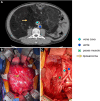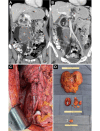Surgical Management of Retroperitoneal Liposarcoma: Opportunities for Multimodality Treatment, Including Systemic Therapy
- PMID: 40778536
- PMCID: PMC12332537
- DOI: 10.1002/cam4.71129
Surgical Management of Retroperitoneal Liposarcoma: Opportunities for Multimodality Treatment, Including Systemic Therapy
Abstract
Introduction: Soft tissue sarcomas are a diverse group of rare cancers, with approximately 15%-20% found in the retroperitoneum. Liposarcomas (LPS) make up approximately half of all retroperitoneal (RP) sarcomas, with most cases classified as either well-differentiated (WD) or dedifferentiated (DD). DD LPS is more aggressive, with a higher local recurrence rate and risk of distant metastasis compared to WD LPS. The purpose of this review is to outline surgical management of RP LPS and highlight the multimodal treatment strategies for both primary and recurrent disease, along with considerations for their effective implementation.
Methods: The current medical literature was reviewed for studies focused on retroperitoneal liposarcoma and its treatment with surgery, radiation, and chemotherapy. The data was interpreted and compiled in the context of expert clinical experience.
Results: Along with histopathologic analysis, tumor biology can inform patient prognosis. Surgery, the standard treatment for RP LPS, can be either curative or palliative. In primary disease, an attempt should be made to achieve wide surgical margins when feasible. Surgery for recurrent disease requires careful timing and an understanding of the potential benefit versus risk. Neoadjuvant radiation therapy can improve local control of RP LPS; however, data supporting the use of neoadjuvant chemotherapy are currently lacking.
Conclusion: Multimodality treatment of RP LPS is complex and requires consideration of tumor biology and extent of disease, along with individual patient characteristics. Multidisciplinary team collaboration is critical for improving outcomes in patients with RP LPS.
Keywords: dedifferentiated; liposarcoma; multimodality surgery; retroperitoneal sarcoma; surgery; well‐differentiated.
© 2025 The Author(s). Cancer Medicine published by John Wiley & Sons Ltd.
Conflict of interest statement
William W. Tseng reports membership on the Soft Tissue Sarcoma Panel for the National Comprehensive Cancer Network Inc. Steven Sun and Kenneth Cardona have nothing to disclose.
Figures


Similar articles
-
Molecular feature-based classification of retroperitoneal liposarcoma: a prospective cohort study.Elife. 2025 May 23;14:RP100887. doi: 10.7554/eLife.100887. Elife. 2025. PMID: 40407808 Free PMC article.
-
Comparison of Two Modern Survival Prediction Tools, SORG-MLA and METSSS, in Patients With Symptomatic Long-bone Metastases Who Underwent Local Treatment With Surgery Followed by Radiotherapy and With Radiotherapy Alone.Clin Orthop Relat Res. 2024 Dec 1;482(12):2193-2208. doi: 10.1097/CORR.0000000000003185. Epub 2024 Jul 23. Clin Orthop Relat Res. 2024. PMID: 39051924
-
Management of urinary stones by experts in stone disease (ESD 2025).Arch Ital Urol Androl. 2025 Jun 30;97(2):14085. doi: 10.4081/aiua.2025.14085. Epub 2025 Jun 30. Arch Ital Urol Androl. 2025. PMID: 40583613 Review.
-
Recurrent giant retroperitoneal dedifferentiated liposarcoma requiring challenging multiorgan resection: a case report.J Med Case Rep. 2025 Jul 3;19(1):313. doi: 10.1186/s13256-025-05379-9. J Med Case Rep. 2025. PMID: 40611302 Free PMC article.
-
Home treatment for mental health problems: a systematic review.Health Technol Assess. 2001;5(15):1-139. doi: 10.3310/hta5150. Health Technol Assess. 2001. PMID: 11532236
References
-
- Popovich J. R., Kashyap S., Gasalberti D. P., and Cassaro S., Sarcoma (StatPearls, 2025). - PubMed
Publication types
MeSH terms
Supplementary concepts
Grants and funding
LinkOut - more resources
Full Text Sources

